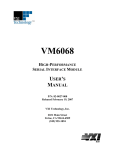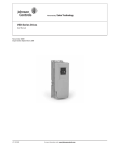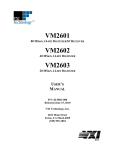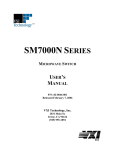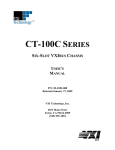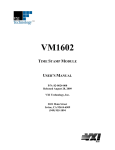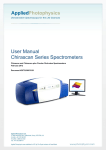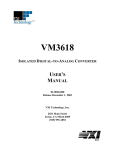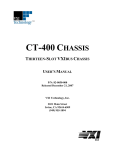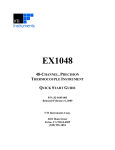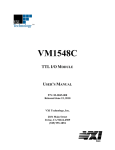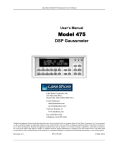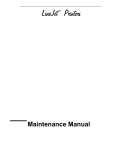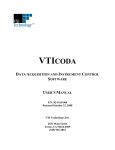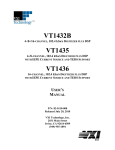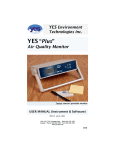Download VM7510 - VTI Instruments
Transcript
VM7510 DC REFERENCE STANDARD USER’S MANUAL P/N: 82-0113-000 Released November 7, 2005 VXI Technology, Inc. 2031 Main Street Irvine, CA 92614-6509 (949) 955-1894 bus 2 www.vxitech.com TABLE OF CONTENTS INTRODUCTION Table of Contents.....................................................................................................................................................3 Certification ..........................................................................................................................................................5 Warranty ...............................................................................................................................................................5 Limitation of Warranty .........................................................................................................................................5 Restricted Rights Legend ......................................................................................................................................5 Declaration of Conformity.......................................................................................................................................6 General Safety Instructions......................................................................................................................................7 Terms and Symbols...............................................................................................................................................7 Warnings...............................................................................................................................................................7 Support Resources ...................................................................................................................................................9 SECTION 1.................................................................................................................................................................11 Introduction............................................................................................................................................................11 Overview.............................................................................................................................................................11 Specifications......................................................................................................................................................13 SECTION 2.................................................................................................................................................................15 Preparation for Use ................................................................................................................................................15 Installation ..........................................................................................................................................................15 Calculating System Power and Cooling Requirements.......................................................................................15 Setting the Chassis Backplane Jumpers ..............................................................................................................16 Setting the Logical Address ................................................................................................................................16 SECTION 3.................................................................................................................................................................17 Programming .........................................................................................................................................................17 Introduction.........................................................................................................................................................17 Programming.......................................................................................................................................................17 Notation ..............................................................................................................................................................18 Alphabetical Command Listing ..........................................................................................................................18 Command Dictionary..........................................................................................................................................20 IEEE 488.2 Common Commands..........................................................................................................................21 *CLS ...................................................................................................................................................................21 *ESE ...................................................................................................................................................................22 *ESR? .................................................................................................................................................................23 *IDN? .................................................................................................................................................................24 *OPC...................................................................................................................................................................25 *RST ...................................................................................................................................................................26 *SRE ...................................................................................................................................................................27 *STB? .................................................................................................................................................................28 *TRG ..................................................................................................................................................................29 *TST? .................................................................................................................................................................30 *WAI ..................................................................................................................................................................31 Instrument Specific SCPI Commands....................................................................................................................32 CALibration:SECure:CODE...............................................................................................................................32 CALibration:SECure:STATe..............................................................................................................................33 DOWNLOAD.....................................................................................................................................................34 SOURce[:ROUTe] / ROUTe ..............................................................................................................................35 VOLTage[:LEVel] / LEVel ................................................................................................................................36 VM7510 Preface 3 VXI Technology, Inc. Required SCPI Commands ....................................................................................................................................37 STATus:OPERation:CONDition? ......................................................................................................................37 STATus:OPERation:ENABle.............................................................................................................................38 STATus:OPERation[:EVENt]? ..........................................................................................................................39 STATus:PRESet .................................................................................................................................................40 STATus:QUEStionable:CONDition? .................................................................................................................41 STATus:QUEStionable:ENABle........................................................................................................................42 STATus:QUEStionable[:EVENt] .......................................................................................................................43 SYSTem:ERRor? ................................................................................................................................................44 SYSTem:VERSion?............................................................................................................................................45 Error Messages ...................................................................................................................................................46 SECTION 4.................................................................................................................................................................47 Calibration .............................................................................................................................................................47 Required Equipment ...........................................................................................................................................47 Procedure ............................................................................................................................................................47 INDEX........................................................................................................................................................................49 4 VM7510 Preface www.vxitech.com CERTIFICATION VXI Technology, Inc. (VTI) certifies that this product met its published specifications at the time of shipment from the factory. VTI further certifies that its calibration measurements are traceable to the United States National Institute of Standards and Technology (formerly National Bureau of Standards), to the extent allowed by that organization’s calibration facility, and to the calibration facilities of other International Standards Organization members. WARRANTY The product referred to herein is warranted against defects in material and workmanship for a period of three years from the receipt date of the product at customer’s facility. The sole and exclusive remedy for breach of any warranty concerning these goods shall be repair or replacement of defective parts, or a refund of the purchase price, to be determined at the option of VTI. For warranty service or repair, this product must be returned to a VXI Technology authorized service center. The product shall be shipped prepaid to VTI and VTI shall prepay all returns of the product to the buyer. However, the buyer shall pay all shipping charges, duties, and taxes for products returned to VTI from another country. VTI warrants that its software and firmware designated by VTI for use with a product will execute its programming when properly installed on that product. VTI does not however warrant that the operation of the product, or software or firmware will be uninterrupted or error free. LIMITATION OF WARRANTY The warranty shall not apply to defects resulting from improper or inadequate maintenance by the buyer, buyersupplied products or interfacing, unauthorized modification or misuse, operation outside the environmental specifications for the product, or improper site preparation or maintenance. VXI Technology, Inc. shall not be liable for injury to property other than the goods themselves. Other than the limited warranty stated above, VXI Technology, Inc. makes no other warranties, express or implied, with respect to the quality of product beyond the description of the goods on the face of the contract. VTI specifically disclaims the implied warranties of merchantability and fitness for a particular purpose. RESTRICTED RIGHTS LEGEND Use, duplication, or disclosure by the Government is subject to restrictions as set forth in subdivision (b)(3)(ii) of the Rights in Technical Data and Computer Software clause in DFARS 252.227-7013. VXI Technology, Inc. 2031 Main Street Irvine, CA 92614-6509 U.S.A. VM7510 Preface 5 VXI Technology, Inc. DECLARATION OF CONFORMITY Declaration of Conformity According to ISO/IEC Guide 22 and EN 45014 MANUFACTURER’S NAME VXI Technology, Inc. MANUFACTURER’S ADDRESS 2031 Main Street Irvine, California 92614-6509 PRODUCT NAME DC Reference Standard MODEL NUMBER(S) VM7510 PRODUCT OPTIONS All PRODUCT CONFIGURATIONS All VXI Technology, Inc. declares that the aforementioned product conforms to the requirements of the Low Voltage Directive 73/23/EEC and the EMC Directive 89/366/EEC (inclusive 93/68/EEC) and carries the “CE” mark accordingly. The product has been designed and manufactured according to the following specifications: SAFETY EN61010 (2001) EMC EN61326 (1997 w/A1:98) Class A CISPR 22 (1997) Class A VCCI (April 2000) Class A ICES-003 Class A (ANSI C63.4 1992) AS/NZS 3548 (w/A1 & A2:97) Class A FCC Part 15 Subpart B Class A EN 61010-1:2001 The product was installed into a C-size VXI mainframe chassis and tested in a typical configuration. I hereby declare that the aforementioned product has been designed to be in compliance with the relevant sections of the specifications listed above as well as complying with all essential requirements of the Low Voltage Directive. November 2005 Steve Mauga, QA Manager 6 VM7510 Preface www.vxitech.com GENERAL SAFETY INSTRUCTIONS Review the following safety precautions to avoid bodily injury and/or damage to the product. These precautions must be observed during all phases of operation or service of this product. Failure to comply with these precautions, or with specific warnings elsewhere in this manual, violates safety standards of design, manufacture, and intended use of the product. Service should only be performed by qualified personnel. TERMS AND SYMBOLS These terms may appear in this manual: WARNING Indicates that a procedure or condition may cause bodily injury or death. CAUTION Indicates that a procedure or condition could possibly cause damage to equipment or loss of data. These symbols may appear on the product: ATTENTION - Important safety instructions Frame or chassis ground Indicates that the product was manufactured after August 13, 2005. This mark is placed in accordance with EN 50419, Marking of electrical and electronic equipment in accordance with Article 11(2) of Directive 2002/96/EC (WEEE). End-of-life product can be returned to VTI by obtaining an RMA number. Fees for take-back and recycling will apply if not prohibited by national law. WARNINGS Follow these precautions to avoid injury or damage to the product: VM7510 Preface Use Proper Power Cord To avoid hazard, only use the power cord specified for this product. Use Proper Power Source To avoid electrical overload, electric shock or fire hazard, do not use a power source that applies other than the specified voltage. Use Proper Fuse To avoid fire hazard, only use the type and rating fuse specified for this product. 7 VXI Technology, Inc. WARNINGS (CONT.) Avoid Electric Shock To avoid electric shock or fire hazard, do not operate this product with the covers removed. Do not connect or disconnect any cable, probes, test leads, etc. while they are connected to a voltage source. Remove all power and unplug unit before performing any service. Service should only be performed by qualified personnel. Ground the Product This product is grounded through the grounding conductor of the power cord. To avoid electric shock, the grounding conductor must be connected to earth ground. Operating Conditions To avoid injury, electric shock or fire hazard: Do not operate in wet or damp conditions. Do not operate in an explosive atmosphere. Operate or store only in specified temperature range. Provide proper clearance for product ventilation to prevent overheating. DO NOT operate if any damage to this product is suspected. Product should be inspected or serviced only by qualified personnel. The operator of this instrument is advised that if the equipment is used in a manner not specified in this manual, the protection provided by the equipment may be impaired. Improper Use Conformity is checked by inspection. 8 VM7510 Preface www.vxitech.com SUPPORT RESOURCES Support resources for this product are available on the Internet and at VXI Technology customer support centers. VXI Technology World Headquarters VXI Technology, Inc. 2031 Main Street Irvine, CA 92614-6509 Phone: (949) 955-1894 Fax: (949) 955-3041 VXI Technology Cleveland Instrument Division 5425 Warner Road Suite 13 Valley View, OH 44125 Phone: (216) 447-8950 Fax: (216) 447-8951 VXI Technology Lake Stevens Instrument Division VXI Technology, Inc. 1924 - 203 Bickford Snohomish, WA 98290 Phone: (425) 212-2285 Fax: (425) 212-2289 Technical Support Phone: (949) 955-1894 Fax: (949) 955-3041 E-mail: [email protected] Visit http://www.vxitech.com for worldwide support sites and service plan information. VM7510 Preface 9 VXI Technology, Inc. 10 VM7510 Preface www.vxitech.com SECTION 1 INTRODUCTION OVERVIEW The VM7510 is a precision dc voltage standard which is designed to be used in conjunction with the VM2601 digitizer. The VM7510 provides a precision ±0.5 V signal which can be used to calibrate the VM2601 beyond its native accuracy specification. Additionally, the VM7510 provides signal-routing capabilities which allows the user to select either the measurement input, the internal precision dc source, or an external ac calibration source. A block diagram of the VM7510 is provided in Figure 1-1. SIGNAL INPUT K1 AC REFERENCE INPUT K3 OUTPUT PROGRAMMABLE DC VOLTAGE STANDARD K2 50 OHM CONTROL LOGIC FIGURE 1-1: VM7510 BLOCK DIAGRAM VM7510 Introduction 11 VXI Technology, Inc. ACC/ERR FAIL J111 J112 VM2601 (see the VM2601 User's Manual for front panel connector information.) J113 J114 J115 J116 ACC/ERR R3 FAIL POS ADJ AC Reference In J1 VM7510 R7 NEG ADJ Signal Input J2 R10 J3 ZERO ADJ Output The multi-turn potentiometers at R3, R7, and R10 are used to adjust the signal from the output connector, J3. See the Calibration section for more information. FIGURE 1-2: FRONT PANEL LAYOUT 12 VM7510 Introduction www.vxitech.com SPECIFICATIONS SIGNAL INPUT AND AC REFERENCE INPUT INSERTION LOSS 100 MHz 500 MHz ISOLATION 10 MHz 100 MHz 500 MHz VSWR 100 MHz < 0.2 dB < 0.5 dB < -80 dB < -70 dB < -65 dB < 1.2:1 DC REFERENCE OUTPUT VOLTAGE +1.000 V, 0.000 V, or -1.000 V into a high impedance load +0.500 V, 0.000 V, or -0.500 V into a 50 Ω load OUTPUT IMPEDANCE 50 Ω OUTPUT DRIVE > 100 mA OUTPUT ACCURACY ±100 µV all output settings, into high impedance OUTPUT ADJUSTMENT ±5.0 mV all output settings, into high impedance. Front panel accessible multi-turn potentiometer. TEMPERATURE STABILITY 25 ppm/°C LONG TERM STABILITY 50 ppm/yr VM7510 Introduction 13 VXI Technology, Inc. 14 VM7510 Introduction www.vxitech.com SECTION 2 PREPARATION FOR USE INSTALLATION When the VM7510 is unpacked from its shipping carton, the contents should include the following items: (1) VM7510 DC Reference Standard (1) VM7510 DC Reference Standard User’s Manual (this manual) The packaging and the VMIP carrier should be immediately inspected for damage upon receipt of the unit. The chassis/mainframe should be checked to ensure that it is capable of providing adequate power and cooling for the VM7510. Once the chassis is found adequate, the VM7510’s logical address and the backplane jumpers of the chassis should be configured prior to the VM7510’s installation. After the chassis is assessed to be in good condition, it may be installed into an appropriate C-size or D-size VXIbus chassis in any slot other than slot zero. CALCULATING SYSTEM POWER AND COOLING REQUIREMENTS The power and cooling requirements of the VM7510 are given in the Specifications section of Section 1 of this manual. It is imperative that the chassis provide adequate power and cooling for this module. Referring to the chassis User’s Manual, confirm that the power budget for the system (the chassis and all modules installed therein) is not exceeded and that the cooling system can provide adequate airflow at the specified backpressure. It should be noted that if the chassis cannot provide adequate power to the module, the instrument might not perform to specification or possibly not operate at all. In addition, if adequate cooling is not provided, the reliability of the instrument will be jeopardized and permanent damage may occur. Damage found to have occurred due to inadequate cooling will void the warranty on the instrument in question. VM7510 Programming 15 VXI Technology, Inc. SETTING THE CHASSIS BACKPLANE JUMPERS Please refer to the chassis User’s Manual for further details on setting the backplane jumpers. SETTING THE LOGICAL ADDRESS The logical address of the VM7510 is set by a single 8-position DIP switch located near the module’s backplane connectors (this is the only switch on the module). The switch is labeled with positions 1 through 8 and with an ON position. A switch pushed toward the ON legend will signify a logic 1; switches pushed away from the ON legend will signify a logic 0. The switch located at position 1 is the least significant bit while the switch located at position 8 is the most significant bit. See Figure 2-1 for examples of setting the logical address switch. ON ON 1 2 3 4 5 6 7 8 1 2 3 4 5 6 7 8 SET TO 4 SET TO 8 ON ON 1 2 3 4 5 6 7 8 1 2 3 4 5 6 7 8 SET TO 168 SET TO 255 (Dynamic) Switch Position Switch Value 1 2 3 4 5 6 7 8 1 2 4 8 16 32 64 128 FIGURE 2-1: LOGICAL ADDRESS SWITCH SETTING EXAMPLES The VMIP may contain three separate instruments and will allocate logical addresses as required by the VXIbus specification (revisions 1.3 through 3.0). The logical address of the instrument is set on the VMIP carrier. The VMIP logical addresses must be set to an even multiple of 4 unless dynamic addressing is used. As a result, switch positions 1 and 2 must always be set to the OFF position unless dynamic address configuration is used. Addresses of 4, 8, 12, 16, ...252 are the only permissible addresses. The address switch should be set for one of these legal addresses and the address for the second instrument (the instrument in the center position) will automatically be set to the switch set address plus one; while the third instrument (the instrument in the lowest position) will automatically be set to the switch set address plus two. If dynamic address configuration is desired, the address switch should be set for a value of 255 (all switches set to ON). Upon power-up, the slot 0 resource manager will assign the first available logical addresses to each instrument in the VMIP module. 16 VM7510 Command Dictionary www.vxitech.com SECTION 3 PROGRAMMING INTRODUCTION This section presents the instrument command set. It includes an alphabetical list of all the commands supported by the VM7510 divided into three sections: IEEE 488.2 commands, the instrument specific SCPI (Standard Commands for Programmable Instruments) commands, and the required SCPI commands. Each command has a brief description of its function, indicates if its value are affected by the *RST command, and provides its default value. Each command is described in detail, one per page. The description is presented in a regular, didactic manner to assist the user in the use of each command. Every command entry describes the exact command and query syntax, the use and range of parameters, and a complete description of the command’s purpose. PROGRAMMING The VM7510 is a VXIbus message-based device whose command set is compliant with the SCPI programming language. SCPI is a tree-structured language based on IEEE-STD-488.2 specifications. Based on this structure, the IEEE-STD-488.2 standard and device-dependent commands may have multiple branches from a trunk without repeating the trunk. To use this facility, terminate each branch with a semicolon. As an example, CONDition?, ENABle, and EVENt? are all branches off the STATus:OPERation trunk and can be combined as follows: STATus:OPERation:CONDition?;ENABle <NRf>;EVENt? The above command is the same as the three commands: STATus:OPERation:CONDition? STATus:OPERation:ENABle STATus:OPERation:EVENt? All module commands are sent over the VXIbus backplane to the module. Commands may be in upper, lower, or mixed case. All numbers are sent in ASCII decimal unless otherwise noted. See Standard Commands for Programmable Instruments (SCPI), Volume 1: Syntax & Style, Section 6 for more information. VM7510 Programming 17 VXI Technology, Inc. The SCPI commands in this section are listed in upper and lower case to indicate different forms of the same command. Keywords may have both a short form and a long form (some commands, however, only have one form). The short form utilizes the uppercase keyword characters. The long form uses both the uppercase and lowercase keyword characters. Either form is acceptable. Note, however, that there are no intermediate forms. All characters from the short and long form of the command must be used. Short forms and long forms may be freely intermixed. The actual commands sent can be in uppercase, lowercase, or the cases may be mixed (case is only used to distinguish short and long form for the user). As an example, these commands are all correct and all have the same effect: CALibration:SECure:CODE <string> CALibration:SECure:CODE <string> calibration:secure:code <string> CAL:SECure:CODE <string> CAL:SEC:CODE <string> cal:sec:code <string> The following command is not correct because it includes characters in addition to those used in the short form of CALibrate: calib:sec:code <string> (incorrect syntax – additional “ib” - only cal or calibration is correct) All of the SCPI commands also have a query form unless otherwise noted. Query forms contain a question mark (?). The query form allows the system to ask what the current setting of a parameter is. The query form of the command generally replaces the parameter with a question mark (?). Query responses do not include the command header. This means only the parameter is returned: no part of the command or "question" is returned. NOTATION Keywords or parameters enclosed in square brackets ([]) are optional. If the optional part is a keyword, the keyword may be included or omitted. Omitting an optional parameter will cause its default to be used. Parameters are enclosed by angle brackets (<>). Braces ({}), or curly brackets, are used to enclose one or more parameters that may be included zero or more times. A vertical bar (|), read as "or", is used to separate parameter alternatives. ALPHABETICAL COMMAND LISTING The following tables provide an alphabetical listing of each command supported by the VM7510 along with a brief description. If an “X” is found in the column titled *RST, then the value or setting controlled by this command is possibly changed by the execution of the *RST command. If no “X” is found, then *RST has no effect. The default column indicates the value of each command’s setting when the unit is powered up or when a *RST command is executed. In order for CALibration commands/queries to be executed, calibration security must be turned off. If security is not turned off, a “-203, ‘Command protected; Can't query security code with secure state on’” error will be returned. See the CALibration:SECure:CODE command for information on calibration security. 18 VM7510 Programming www.vxitech.com TABLE 3-1: IEEE 488.2 COMMON COMMANDS Command *CLS *ESE *ESR? *IDN? *OPC *RST *SRE *STB? *TRG *TST? *WAI Description Clear the Status Register. Set the Event Status Enable Register. Query the Standard Event Status Register Query the module identification string. Set the OPC bit in the Event Status Register Reset the module to a known state Set the service request enable register Query the Status Byte Register. Causes a trigger event to occur. Starts and reports a self-test procedure. Halts execution and queries *RST X X *RST Value N/A N/A N/A 0 N/A N/A N/A N/A N/A N/A TABLE 3-2: INSTRUMENT SPECIFIC SCPI COMMANDS Command CALibration:SECure:CODE CALibration:SECure:STATe DOWNLOAD SOURce[:ROUTe] / ROUTe VOLTage[:LEVel] / LEVel Description Sets the calibration security password. Sets or clears the security state of the instrument Loads firmware updates into a module Selects the signal to route to the output Selects the dc reference output voltage *RST X *RST Value N/A Secure X X Ground Zero *RST *RST Value X X X X X X X X Clears queue TABLE 3-3: SCPI REQUIRED COMMANDS Command Description STATus:OPERation:CONDition? STATus:OPERation:ENABle STATus:OPERation[:EVENt]? STATus:PRESet STATus:QUEStionable:ENABle STATus:QUEStionable:ENABle STATus:QUEStionable[:EVENt] SYSTem:ERRor? SYSTem:VERSion? Query the Operation Status Condition Register. Sets the Operation Status Enable Register. Query the Operation Status Event Register. Presets the Status Register. Query the Questionable Status Condition Register Sets the Questionable Status Enable Register. Query the Questionable Status Event Register Query the Error Queue Query the version of the SCPI standard to which module complies. VM7510 Programming N/A 19 VXI Technology, Inc. COMMAND DICTIONARY The remainder of this section is devoted to the actual command dictionary. Each command is fully described on its own page. In defining how each command is used, the following items are described: Purpose Describes the purpose of the command. Type Describes the type of command such as an event or setting. Command Syntax Details the exact command format. Command Parameters Describes the parameters sent with the command and their legal range. Reset Value Describes the values assumed when the *RST command is sent. Query Syntax Details the exact query form of the command. Query Parameters Describes the parameters sent with the command and their legal range. The default parameter values are assumed the same as in the command form unless described otherwise. Query Response Describes the format of the query response and the valid range of output. Description Describes in detail what the command does and refers to additional sources. Examples Present the proper use of each command and its query (when available). Related Commands Lists commands that affect the use of this command or commands that are affected by this command. 20 VM7510 Programming www.vxitech.com IEEE 488.2 COMMON COMMANDS *CLS Purpose Clears the Status Register. Type IEEE 488.2 Common Command Command Syntax *CLS Command Parameters None *RST Value *RST performs all the functions of *CLS Query Syntax None - command only Query Parameters N/A Query Response N/A Description This command clears all event registers, clears the *OPC flag and clears all queues (except the output queue). Examples Command / Query *CLS Related Commands None VM7510 Programming Response (Description) (Clears all status and event registers) 21 VXI Technology, Inc. *ESE Purpose Sets the bits of the Event Status Enable Register Type IEEE 488.2 Common Command Command Syntax *ESE <mask> Command Parameters <mask> = numeric ASCII value from 0 to 255 *RST Value N/A Query Syntax *ESE? Query Parameters None Query Response Numeric ASCII value from 0 to 255 Description The Event Status Enable command is used to set the bits of the Event Status Enable Register. See ANSI/IEEE 488.2-1987 section 11.5.1 for a complete description of the ESE register. A value of 1 in a bit position of the ESE register enables generation of the ESB (Event Status Bit) in the Status Byte by the corresponding bit in the ESR. If the ESB is set in the SRE register then an interrupt will be generated. See the *ESR? command for details regarding the individual bits. The ESE register layout is: Bit 0 - Operation Complete Bit 1 - Request Control (not used in the VM7510) Bit 2 - Query Error Bit 3 - Device Dependent Error (not used in the VM7510) Bit 4 - Execution Error Bit 5 - Command Error Bit 6 - User Request (not used in the VM7510) Bit 7 - Power On The Event Status Enable query reports the current contents of the Event Status Enable Register. Examples Related Commands 22 Command / Query *ESE 36 Response (Description) *ESE? 36 (Returns the value of the event status enable register) *ESR? VM7510 Programming www.vxitech.com *ESR? Purpose Queries and clears the Standard Event Status Register Type IEEE 488.2 Common Command Command Syntax None – query only Command Parameters N/A *RST Value N/A Query Syntax ESR? Query Parameters None Query Response Numeric ASCII value from 0 to 255 Description The Event Status Register query - queries and clears the contents of the Standard Event Status Register. This register is used in conjunction with the ESE register to generate the ESB (Event Status Bit) in the Status Byte. The layout of the ESR is: Bit 0 - Operation Complete Bit 1 - Request Control (not used in the VM7510, always 0) Bit 2 - Query Error Bit 3 - Device Dependent Error (not used in the VM7510, always 0) Bit 4 - Execution Error Bit 5 - Command Error Bit 6 - User Request (not used in the VM7510, always 0) Bit 7 - Power On The Operation Complete bit is set by the VM7510 when it receives an *OPC command. The Query Error bit is set when data is over-written in the output queue. This could occur if one query is followed by another without reading the data from the first query. The Execution Error bit is set when an execution error is detected. See the section in the manual covering Error Messages for a list of execution error. Errors that range from -200 to -299 are execution errors. The Command Error bit is set when a command error is detected. See the section in this manual covering Error Messages for a list of command errors. Errors that range from -100 to -199 are command errors. The Power On bit is set when the module is first powered on or after it receives a reset via the VXI Control Register. Once the bit is cleared (by executing the *ESR? command) it will remain cleared. Examples Command / Query *ESR? Related Commands *ESE VM7510 Programming Response (Description) 4 23 VXI Technology, Inc. *IDN? Purpose Queries the module for its identification string Type IEEE 488.2 Common Command Command Syntax None – query only Command Parameters N/A *RST Value N/A Query Syntax *IDN? Query Parameters None Query Response ASCII character string Description The Identification query returns the identification string of the VM7510 module. The response is divided into four fields separated by commas. The first field is the manufacturer’s name, the second field is the model number, the third field is an optional serial number, and the fourth field is the firmware revision number. If a serial number is not supplied, the third field is set to 0 (zero). Examples Command / Query *IDN? Response (Description) VXI Technology, Inc.,VM7510,0,1.0 (The revision listed here is for reference only; the response will always be the current revision of the instrument.) Related Commands 24 None VM7510 Programming www.vxitech.com *OPC Purpose Sets the OPC bit in the Event Status Register Type IEEE 488.2 Common Command Command Syntax *OPC Command Parameters None *RST Value N/A Query Syntax *OPC? Query Parameters None Query Response 1 Description The Operation Complete command sets the OPC bit in the Event Status Register when all pending operations have completed. The Operation Complete query will return a 1 to the output queue when all pending operations have completed. Examples Command / Query *OPC Response (Description) (Sets the OPC bit in the Event Status Register) *OPC? 1 (Returns the value of the Event Status Register) Related Commands VM7510 Programming *WAI 25 VXI Technology, Inc. *RST Purpose Resets the module’s hardware and software to a known state Type IEEE 488.2 Common Command Command Syntax *RST Command Parameters None *RST Value N/A Query Syntax None Query Parameters N/A Query Response N/A Description The Reset command resets the module’s hardware and software to a known state. See the Alphabetical Command Listing at the beginning of this chapter for the default parameter values set by this command. Examples Command / Query *RST Related Commands None 26 Response (Description) (Resets the module) VM7510 Programming www.vxitech.com *SRE Purpose Set the service request enable register Type IEEE 488.2 Common Command Command Syntax *SRE <mask> Command Parameters <mask> =numeric ASCII value from 0 to 255 *RST Value None – Required parameter Query Syntax *SRE? Query Parameters None Query Response Numeric ASCII value from 0 to 255 Description The service request enable mask is used to control which bits in the status byte generate back plane interrupts. If a bit is set in the mask that newly enables a bit set in the status byte and interrupts are enabled, the module will generate a REQUEST TRUE event via an interrupt. See the *STB? Command for the layout of bits. Note: Bit 6 is always internally cleared to zero as required by IEEE 488.2 section 11.3.2.3. Bit 0 - Latch Event Bit 1 - Unused Bit 2 - Error Queue Has Data Bit 3 - Questionable Status Summary (not used) Bit 4 - Message Available Bit 5 - Event Status Summary Bit 6 - Master Summary Status Bit 7 - Operation Status Summary Examples Related Commands VM7510 Programming Command / Query *SRE 4 Response (Description) (Sets the service request enable register) *SRE? 4 (Returns the value of the SRE register) *STB 27 VXI Technology, Inc. *STB? Purpose Queries the Status Byte Register Type IEEE 488.2 Common Command Command Syntax None – query only Command Parameters N/A *RST Value N/A Query Syntax *STB? Query Parameters None Query Response Numeric ASCII value from 0 to 255 Description The Read Status Byte query fetches the current contents of the Status Byte Register. See the IEEE 488.2 specification for additional information regarding the Status byte Register and its use. The layout of the Status Register is: Bit 0 - Latched Event Bit 1 - Unused Bit 2 - Error Queue Has Data Bit 3 - Questionable Status Summary (not used) Bit 4 - Message Available Bit 5 - Event Status Summary Bit 6 - Master Summary Status Bit 7 - Operation Status Summary Examples Command / Query *STB? Related Commands None 28 Response (Description) 16 (Queries the Status Byte Register) VM7510 Programming www.vxitech.com *TRG Purpose Causes a trigger event to occur Type IEEE 488.2 Common Command Command Syntax *TRG Command Parameters None *RST Value N/A Query Syntax None Query Parameters N/A Query Response N/A Description The Trigger command causes a trigger event to occur. This command is not used for this module and is provided for SCPI compliance only. Examples Command / Query *TRG Related Commands None VM7510 Programming Response (Description) (Triggers an event) 29 VXI Technology, Inc. *TST? Purpose Causes a self-test procedure to occur and queries the result Type IEEE 488.2 Common Command Command Syntax None – query only Command Parameters N/A *RST Value N/A Query Syntax *TST? Query Parameters None Query Response Numeric ASCII value Description The Self-Test query causes the VM7510 to run its self-test procedures and report on the results. A value of 0 indicates that the test passed. Examples Command / Query *TST? Related Commands None 30 Response (Description) 0 (Begins the self-test procedure returns the result) VM7510 Programming www.vxitech.com *WAI Purpose Halts execution of commands and queries until the No Operation Pending message is true Type IEEE 488.2 Common Command Command Syntax *WAI Command Parameters None *RST Value N/A Query Syntax None Query Parameters N/A Query Response N/A Description The Wait to Continue command halts the execution of commands and queries until the No Operation Pending message is true. This command makes sure that all previous commands have been executed before processing. It provides a way of synchronizing the module with its master. Examples Command / Query *WAI Related Commands *OPC VM7510 Programming Response (Description) (Pauses the execution of additional commands until the No Operation Pending message is true.) 31 VXI Technology, Inc. INSTRUMENT SPECIFIC SCPI COMMANDS CALibration:SECure:CODE Purpose Sets the calibration security password. Type Setting Command Syntax CALibration:SECure:CODE <string> Command Parameters <string> = the code string can be from 1 to 15 ASCII characters in length entered in IEEE-488.2 definite or indefinite length arbitrary block format. *RST Value N/A Query Syntax CALibration:SECure:CODE <string>? Query Parameters N/A Query Response Returns the set value of the <string> parameter Description The Calibration Security Code command sets the code required to disable calibration security. Calibration security must first be disabled before the code can be changed. Before shipping the instrument, the factory code setting is VM7510. Examples Command / Query CAL:SEC:CODE #16VM7510 Related Commands CALibration:SECure:STATe 32 Response (Description) (Sets the factory code setting of VM7510) VM7510 Programming www.vxitech.com CALibration:SECure:STATe Purpose Enable or disable the calibration security. Type Setting Command Syntax CALibration:SECure:STATe <boolean>,<string> Command Parameters <boolean> = 0 | 1 | OFF | ON <string> = the code string can be from 1 to 15 ASCII characters in length entered in IEEE-488.2 definite or indefinite length arbitrary block format. *RST Value <boolean> = 1 Query Syntax CALibration:SECure:STATe? Query Parameters N/A Query Response 0|1 Description The module powers up with the secure state enabled. While security is on, no stores to non-volatile memory are allowed. This command turns the state on or off. In order to disable the security state, the current security code must be supplied. To turn on security, code does not need to be supplied. If it is supplied the code is checked. The security code must be supplied in IEEE-488.2 definite or indefinite length arbitrary block format. Calibration commands should only be executed by qualified personnel. Changing these values incorrectly can cause the instrument to perform improperly. Examples Command / Query CAL:SEC:STAT OFF,#16VM7510 CAL:SEC:STAT 1 CAL:SEC:STAT? Related Commands VM7510 Programming Response (Description) (Disables calibration security) (Turns the calibration security back on) 1 (Indicates that calibration security is enabled) CALibration:SECure:CODE 33 VXI Technology, Inc. DOWNLOAD Purpose Loads firmware updates into a module Type Event Command Syntax DOWNLOAD <section> Command Parameters <section> = 0 | 1 | 2 | 3 0 is for the VMIP base code 1 is for the module in the top position 2 is for the module in the middle position 3 is for the module in the bottom position *RST Value N/A Query Syntax N/A Query Parameters None Query Response N/A Description Firmware for VMIP cards is stored in FLASH memory which can be updated in the field. Each card has at least 4 separate areas where firmware is stored. This command is used to update one area of the firmware. To update a module, do the following: 1. Obtain the proper HEX file from the factory. 2. Send the DOWNLOAD command with the appropriate <section>. 3. Send each line of the HEX file to the module (one line at a time). 4. Wait at least 15 seconds after the last line of the HEX file is sent. 5. Turn power to the module off. 6. Turn power back on and perform normal start up operations. If more than one module needs to be updated, repeat the procedure for each section to be updated. Improper use of this command can completely disable the instrument. NOTE: This command can only be used on the module in the top position. If there is no module in the top position, the command is sent to a dummy application. The top module/application always has an address that is an integer multiple of 4. Even though the command and the HEX file are always sent to the top module/application, the module corresponding to the <section> is the one that is updated. Examples Related Commands 34 Command / Query DOWNLOAD 1 S0... : S8... Response (Description) (First line of HEX file) (Last line of HEX file) None VM7510 Programming www.vxitech.com SOURce[:ROUTe] / ROUTe Purpose Selects the signal to be routed to the output jack. Type Setting Command Syntax SOURce[:ROUTe] <string> or ROUTe <string> Command Parameters <string> = SIGnal | ACRef | DCRef | GND *RST Value SIG Query Syntax SOURce[:ROUTe]? or ROUTe? Query Parameters N/A Query Response Returns: SIG | ACR | DCR | GND Description The SOURce[:ROUTe] route command selects the signal source for the output jack. ROUTe can also be used to execute this command. Examples Related Commands VM7510 Programming Command / Query SOUR SIG Response (Description) (Selects the Signal input to be routed to the Output jack). SOUR? SIG (Indicates the Signal input is routed to the output jack). ROUTe 35 VXI Technology, Inc. VOLTage[:LEVel] / LEVel Purpose Sets the dc reference output voltage level Type Setting Command Syntax VOLTage[:LEVel] <value> or LEVel <value> Command Parameters <value> = POSitive | NEGative | ZERo *RST Value N/A Query Syntax VOLTage[:LEVel]? or LEVel? Query Parameters N/A Query Response <value> = POS | NEG | ZERO Description The VOLTage[:LEVel] command sets the output of the dc reference standard to either the positive, negative, or zero voltage level. LEVel can also be used to execute this command. Examples Related Commands 36 Command / Query VOLT POS Response (Description) (Sets the dc reference output to the positive output level) VOLT? POS (Indicates the dc reference is set for a positive voltage output) LEVel VM7510 Programming www.vxitech.com REQUIRED SCPI COMMANDS STATus:OPERation:CONDition? Purpose Queries the Operation Status Condition Register Type Required SCPI command Command Syntax None – query only Command Parameters N/A *RST Value N/A Query Syntax STATus:OPERation:CONDition? Query Parameters None Query Response 0 Description The Operation Status Condition Register query is provided for SCPI compliance only. The VM7510 does not alter the state of any of the bits in this register and always reports a 0. Examples Command / Query STAT:OPER:COND? Related Commands None VM7510 Programming Response (Description) 0 37 VXI Technology, Inc. STATus:OPERation:ENABle Purpose Sets the Operation Status Enable Register Type Required SCPI command Command Syntax STATus:OPERation:ENABle <NRf> Command Parameters <NRf> = numeric ASCII value from 0 to 32767 *RST Value NRf must be specified Query Syntax STATus:OPERation:ENABle? Query Parameters None Query Response Numeric ASCII value from 0 to 32767 Description The Operation Status Enable Register is included for SCPI compatibility and the VM7510 does not alter any of the bits in this register. The register layout is as follows: Bit 0 - Calibrating Bit 1 - Setting Bit 2 - Ranging Bit 3 - Sweeping Bit 4 - Measuring Bit 5 - Waiting for trigger Bit 6 - Waiting for arm Bit 7 - Correcting Examples Command / Query STAT:OPER:ENAB 0 Related Commands None 38 Response (Description) 0 VM7510 Programming www.vxitech.com STATus:OPERation[:EVENt]? Purpose Queries the Operation Status Event Register Type Required SCPI command Command Syntax None – query only Command Parameters N/A *RST Value N/A Query Syntax STATus:OPERation [:EVENt]? Query Parameters None Query Response 0 Description The Status Operation Event Register query is included for SCPI compliance. The VM7510 does not alter any of the bits in this register and always reports a 0. Examples Command / Query STAT:OPER? Related Commands None VM7510 Programming Response (Description) 39 VXI Technology, Inc. STATus:PRESet Purpose Presets the Status Registers Type Required SCPI command Command Syntax STATus:PRESet Command Parameters None *RST Value N/A Query Syntax None – command only Query Parameters N/A Query Response N/A Description The Status Preset command presets the Status Registers. The Operational Status Enable Register is set to 0 and the Questionable Status Enable Register is set to 0. This command is provided for SCPI compliance only. Examples Command / Query STAT:PRES Related Commands None 40 Response (Description) (Presets the Status Registers) VM7510 Programming www.vxitech.com STATus:QUEStionable:CONDition? Purpose Queries the Questionable Status Condition Register Type Required SCPI command Command Syntax None – query only Command Parameters N/A *RST Value N/A Query Syntax STATus:QUEStionable:CONDition? Query Parameters None Query Response 0 Description The Questionable Status Condition Register query is provided for SCPI compliance only. The VM7510 does not alter any of the bits in this register and a query always reports a 0. Examples Command / Query STAT:QUES:COND? Related Commands None VM7510 Programming Response (Description) 0 41 VXI Technology, Inc. STATus:QUEStionable:ENABle Purpose Sets the Questionable Status Enable Register Type Required SCPI command Command Syntax STATus:QUEStionable:ENABle <NRf> Command Parameters <NRf> = numeric ASCII value from 0 to 32767 *RST Value NRf must be supplied Query Syntax STATus:QUEStionable:ENABle? Query Parameters None Query Response Numeric ASCII value from 0 to 32767 Description The Status Questionable Enable command sets the bits in the Questionable Status Enable Register. This command is provided only to comply with the SCPI standard. The Status Questionable Enable query reports the contents of the Questionable Status Enable Register. The VM7510 does not alter the bit settings of this register and will report the last programmed value. Examples Related Commands 42 Command / Query STAT:QUES:ENAB 64 Response (Description) STAT:QUES:ENAB? 64 None VM7510 Programming www.vxitech.com STATus:QUEStionable[:EVENt] Purpose Queries the Questionable Status Event Register Type Required SCPI command Command Syntax None – query only Command Parameters N/A *RST Value N/A Query Syntax STATus:QUEStionable [:EVENt]? Query Parameters None Query Response 0 Description The Questionable Status Event Register is provided for SCPI compliance only. The VM7510 does not alter the bits in this register and queries always report a 0. Examples Command / Query STAT:QUES? Related Commands None VM7510 Programming Response (Description) 0 43 VXI Technology, Inc. SYSTem:ERRor? Purpose Queries the Error Queue Type Required SCPI command Command Syntax None – query only Command Parameters N/A *RST Value N/A Query Syntax SYSTem:ERRor? Query Parameters None Query Response ASCII string Description The System Error query is used to retrieve error messages from the error queue. The error queue will maintain the two error messages. If additional errors occur, the queue will overflow and the second and subsequent error messages will be lost. In the case of an overflow, an overflow message will replace the second error message. See the SCPI standard Volume 2: Command Reference for details on errors and reporting them. Refer to the Error Messages section of this manual for specific details regarding the reported errors. Examples Command / Query SYST:ERR? Related Commands None 44 Response (Description) -310, "System error; Unrecognized MUX setting" VM7510 Programming www.vxitech.com SYSTem:VERSion? Purpose Queries the SCPI version number to which the VM7510 complies Type Required SCPI command Command Syntax None – query only Command Parameters N/A *RST Value N/A Query Syntax SYSTem:VERSion? Query Parameters None Query Response Numeric ASCII value Description The System Version query reports version of the SCPI standard to which the VM7510 complies. Examples Command / Query SYST:VERS? Related Commands None VM7510 Programming Response (Description) 1994.0 45 VXI Technology, Inc. ERROR MESSAGES Should an error occur while commands are being sent to the VM7510, the following error messages may appear. These messages are in compliance with SCPI standards and can be retrieved by using the SYSTem:ERRor? query. -101, "Invalid character; Internal error, please contact factory" -109, "Missing Parameter value" -160, "Block data error; Block length was non-numeric" -160, "Block data error; Character after # wasn't a digit" -161, "Invalid block data; Expected more data than what was supplied" -200, "Execution error; Failed reading EEPROM." -200, "Execution error; Failed writing EEPROM." -203, "Command protected; Can't change security code with secure state on" -203, "Command protected; Can't query security code with secure state on" -221, "Settings conflict; DOWNLOAD can only be used by the top module" -222, "Data out of range; Valid OPER:ENAB values are 0 to 32767" -222, "Data out of range; Valid sections are 0 to 3" -223, "Too much data; Security buffer full" -224, "Illegal parameter value" -310, "System error; Unrecognized MUX setting" 46 VM7510 Programming www.vxitech.com SECTION 4 CALIBRATION REQUIRED EQUIPMENT The following equipment is required for the VM7510 calibration procedure: • • • • • • • VXIbus chassis (VXI Technology CT-100B or equivalent) VXIbus slot 0 controller (National Instruments MXI-2 controller or equivalent) Desktop Computer (PC with Window XP or equivalent) 6 ½ digit voltmeter (Keithley 2000 or equivalent) SMB plug to dual banana plug cable Small flat blade screwdriver VM7510 plug&play drivers and soft front panel PROCEDURE The following procedure can be used to calibrate the VM7510: 1) Remove the cables attached to J1, J2, and J3. 2) Install the VM7510 into the VXIbus chassis. 3) Set the DMM to the 2 V dc range and connect the DMM to J3 of the VM7510. 4) Run the resource manager and open the VM7510 soft front panel. 5) Allow the setup to stabilize thermally for 30 min. 6) Using the soft front panel, select ground as the input source, and zero the DMM by pressing the “relative” button on its front panel. This removes any thermal offsets in the calibration cabling. 7) Using the soft front panel, select the DC Reference as the input source and select POS as the reference output. Adjust R3 on the VM7510 front panel for as close to 1.000000 V as possible. Then, select the reference output to NEG and adjust R7 on the front panel for as close to -1.000000 V as possible. Note that the R3 will affect the NEG output voltage, but R7 will not affect the POS output. Now, select ZERO for the reference output and adjust R10 on the front panel to as close to 0.000000 V as possible. The VM7510 is now calibrated. VM7510 Calibration 47 VXI Technology, Inc. 48 VM7510 Calibration www.vxitech.com INDEX Symbols L *CLS.................................................................................21 *ESE ...........................................................................22, 23 *ESR? ...............................................................................23 *IDN? ...............................................................................24 *OPC ....................................................................23, 25, 31 *RST.................................................................................26 *SRE.................................................................................27 *STB? .........................................................................27, 28 *TRG ................................................................................29 *TST .................................................................................30 *WAI ..........................................................................25, 31 LEVel............................................................................... 36 logical address............................................................ 15, 16 B backplane..........................................................................17 backplane jumpers ......................................................15, 16 block diagram ...................................................................11 C M message-based.................................................................. 17 P parameter.......................................................................... 18 parameters ........................................................................ 17 power................................................................................ 15 programming .................................................................... 17 programming language..................................................... 17 R ROUTe ............................................................................. 35 S declaration of conformity ...................................................6 default parameter ..............................................................26 DOWNLOAD...................................................................34 dynamic address configuration .........................................16 SOURce[:ROUTe] ..................................................... 19, 35 specifications.................................................................... 13 STATus:OPERation:CONDition?.................................... 37 STATus:OPERation:ENABle .......................................... 38 STATus:OPERation[:EVENt]?........................................ 39 STATus:PRESet............................................................... 40 STATus:QUEStionable:CONDition?............................... 41 STATus:QUEStionable:ENABle ..................................... 42 STATus:QUEStionable[:EVENt]..................................... 43 support resources................................................................ 9 syntax ............................................................................... 17 SYSTem:ERRor? ............................................................. 44 SYSTem:VERSion? ......................................................... 45 E T errror messages .................................................................46 tree-structured language ................................................... 17 F V FLASH memory ...............................................................34 front panel.........................................................................12 VOLTage[:LEVel] ..................................................... 19, 36 VXIbus ....................................................................... 15, 17 I W installation ........................................................................15 WEEE ................................................................................ 7 calibration .........................................................................47 CALibration:SECure:CODE ............................................32 CALibration:SECure:STATe............................................33 clear ..................................................................................21 command set .....................................................................17 cooling ..............................................................................15 D K keyword ............................................................................18 VM7510 Index 49


















































